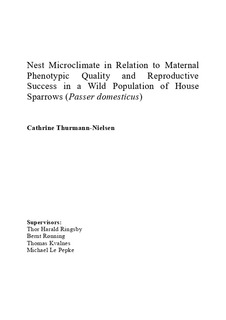| dc.contributor.advisor | Ringsby, Thor Harald | |
| dc.contributor.advisor | Rønning, Bernt | |
| dc.contributor.advisor | Kvalnes, Thomas | |
| dc.contributor.advisor | Pepke, Michael Le | |
| dc.contributor.author | Thurmann-Nielsen, Cathrine | |
| dc.date.accessioned | 2019-11-16T15:01:48Z | |
| dc.date.available | 2019-11-16T15:01:48Z | |
| dc.date.issued | 2019 | |
| dc.identifier.uri | http://hdl.handle.net/11250/2628802 | |
| dc.description.abstract | En bedre forståelse av faktorene som påvirker produksjonen av flyvedyktige unger og rekrutterende fugler er viktig for å forstå økologiske og evolusjonære prosesser. De tidligste livsstadiene er kritiske for overlevelse, som hos fugler er svært avhengig av erfaringer i reiret. Et viktig karaktertrekk for fuglereir er mikroklimaet siden både egg og fugleunger har fysiologiske klimakriterier for å klekke og overleve. Dette mikroklimaet er spesielt kritisk i kalde og fuktige områder hvor det optimale klimaet kan avvike betydelig fra de klimatiske forholdene i omgivelsene. Objektivet i dette studiet var å undersøke mikroklimaet og dets forhold til både mors fenotypiske kvalitet og reproduktiv suksess i en vill gråspurvpopulasjon (Passer domesticus) i Nord-Norge ved å måle temperatur og fuktighet nær reirskålen i løpet av de siste syv dagene før klekking.
Reirmikroklimaet var repeterbart innen mødre, noe som tyder på at reirmikroklimaet er et stabilt individualistisk trekk for gråspurvhunner og studien fant støtte for hypotesen om den utvidede fenotypen for fuglereir. Gjennomsnittstemperatur, variasjonskoeffisienten for temperatur og gjennomsnittsfuktighet i reir var alle påvirket av mors alder. Resultatene indikerte også at gjennomsnittstemperatur i reirene var påvirket av nebbformen til mødrene, men effekten var usikker. En effekt av reirmikroklima på reproduktiv suksess ble funnet da færre fugleunger nådde flyvedyktig alder i reir med høyere fuktighet og større temperaturvariasjon, som gir ytterliggere bevis for viktigheten av de mikroklimatiske forholdene i reiret i løpet av rugeperioden for fuglers reproduktive suksess. | |
| dc.description.abstract | A better understanding of the factors affecting fledgling and recruit production is important in order to understand ecological and evolutionary processes. The early stages of life are crucial for survival, which in avian species is highly dependent on the experience in the nest. An important characteristic of avian nests is the microclimate as both eggs and nestlings have physiological criteria for the climatic conditions in order to hatch and survive. This microclimate is especially crucial in cold and humid areas where the optimal climate can differ substantially from the ambient climate. The objective of this study was to investigate the microclimate and its relationship with both maternal phenotypic quality and reproductive success in a wild house sparrow (Passer domesticus) population in northern Norway by measuring the temperature and humidity close to the nest cup during the last seven days before hatching.
Nest microclimate was repeatable within mothers, suggesting that nest microclimate is a stable individual characteristic of female house sparrows and the study found support for the extended phenotype hypothesis of avian nests. Mean temperature, coefficient of variance of temperature and mean humidity in nests were all affected by the age of the mothers. The results also indicated that mean temperature within nests was influenced by the bill shape of the mother, but the effect was uncertain. An effect of the nest microclimate on the reproductive success was found as fewer fledglings were produced in nests with higher humidity and larger temperature variability, measured as the coefficient of variance of nest temperature, providing further evidence of the importance of the microclimatic conditions in the nests during incubation on avian reproductive success. | |
| dc.language | eng | |
| dc.publisher | NTNU | |
| dc.title | Nest Microclimate in Relation to Maternal Phenotypic Quality and Reproductive Success in a Wild Population of House Sparrows (Passer domesticus) | |
| dc.type | Master thesis | |
